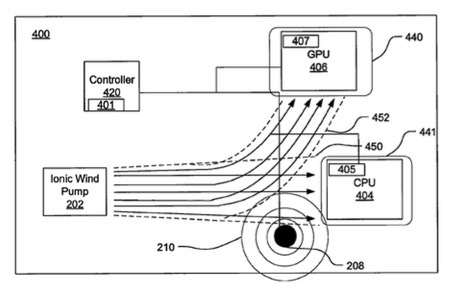Apple has been granted a patent (number 8305728) by the U.S. Patent & Trademark Office for a . It involves a cooling system that blows ionized air through an electronic device, controlling its path by creating electromagnetic fields that can be dynamically adjusted to direct cooling where it’s needed.
Embodiments provide various apparatus and techniques for deflecting or redirecting a flow of ionized air generated from an ionic wind generator. In general, a deflection field generator can be located proximate to the path of the flow of ionized air. The deflection field generator is configured to generate an electromagnetic field, which deflects a least a portion of the flow of ionized air to a different path and may possibly increase local heat transfer.
Here’s Apple’s background on the invention: “Many modern electronic systems generate a large amount of heat, and a variety of different cooling mechanisms may be used to cool these electronic systems. For personal electronic systems, such as computers and other relatively transportable electronic systems, the cooling devices in use today are primarily mechanically-based devices, such as electric fans and heat sinks. A cooling device that has been proposed for use in such systems is an ionic wind generator, which generates airflow based on the ionization of air molecules.
“A limitation of currently-proposed ionic wind generator cooling systems for such devices (and for other conventional cooling devices as well) is that the generated airflow, from a first electrode toward a second electrode is limited to a linear path which is essentially static, and thus can only cool a specific region of an electronic system; particularly, only the regions that are in, or immediately adjacent, the path of the airflow can be cooled.
“While the size, placement, and relative orientation of the two electrodes can be established to provide a linear path of a desired direction and dimension so as to provide a selected degree of airflow-based cooling in that region; such systems inherently involve compromises in terms of either performance or cooling capability. For example, because of the fixed path, the ionic wind generator cooling systems must be designed to provide airflow of a sufficient dimension, and in a sufficient amount, to meet all foreseeable cooling needs.
“However, as can be seen from the example of a computer system (such as, for example, a laptop computer), there may be substantial differences in the usage of the processors and other heat sources in the computer at different times, and thus a cooling system designed to meet the highest-level cooling needs may be using more power than would be necessary at times of relatively lower level cooling needs. Additionally, some components within the example laptop computer may not always be in substantial use, such as a graphics processor, that exacerbate heat generation.
“Thus, airflow directed to such a component when it is not heavily used, and is thus generating little heat, again is requiring a greater energy budget that would be otherwise required. Thus, the limitations of such currently proposed ionic wind generator cooling systems for many electronic devices are limited relative to the variable cooling needs of many such systems.”
The inventors are Jean L. Lee and Richard Lidio Bianco Jr.
Also granted today by the U.S. Patent & Trademark Office are:
° Patent number D670,161 for the design of a display apparatus.
° Patent number D670286 for the design of a portable display device (the iPad screen);
° Patent number RE42796 for the design of a receptacle connector;
° Patent number 8303151 for a microperforation illumination. It’s for methods and apparatuses related to backlit visual display elements.
° Patent number 8307292 for a method and apparatus for binding user interface objects to application objects;
° Patent number 8307236 is for oversampling-based scheme for synchronous interface communication;
° Patent number 8307004 for systems and methods for storing and restoring digital data;
° Patent number 8306918 for the use of a media storage structure with multiple pieces of content in a content-distribution system;
° Patent number 83065761 for heat removal in compact computing systems;
° Patent number RE42796 for the design of a receptacle connector;
° Patent number 8307366 for a method and apparatus for processing a computing job in a distributed processing system;
° Patent number 8307146 for communication between a host device and an accessory via an intermediate device;
° Patent number 8307134 for method and apparatus of a portable storage device that provides a tethering and portable storage service to a host;
° Patent number 8307197 for methods and apparatuses for transmitting multimedia data using streaming media protocols such as real-time transfer protocols (RTP) and real-time streaming protocols (RTSP) in a computer network environment;
° Patent number 8306772 for a method of estimating temperature at a critical point;
° Patent number 8306488 for signal transmitter linearization;
° Patent number 8306475 for a method and apparatus for configuring a wireless device through reverse advertising;
° Patent number 8306367 for a method and apparatus for managing image processing operations;
° Patent number 8306252 for systems and methods for media devices including a housing, a frame disposed adjacent to the housing, and a microphone assembly that is integrated with the frame for receiving sound;
° Patent number 8306235 for a method and apparatus for using a sound sensor to adjust the audio output for a device;
° Patent number 83062034 for a method for communicating additional network information using a synchronization identifier;
° Patent number 8305744 for an apparatus, systems and methods for shock mounting glass for an electronic device.

